These wraps are easy to make, there is barely any washing up and they taste amazing! They are really healthy and spinach is a great source of vitamins K, A and C. You only need 4 ingredients for these wraps and you can add any fillings you want to get even more of your five a day. Wraps are a fun, hands-on food to make and eat so they are perfect for cooking with kids! You can even make them in advance, wrap them in tinfoil and store them in the fridge or freezer for another day – ideal for cooking on a rainy day!
Ingredients:
- 180g spinach
- 375g whole wheat flour
- 45g unsalted butter
- 1 1/2 tsp salt
Method:
- Pour boiling water over the spinach in a bowl and leave it for 2-3 minutes.
- Once the spinach has wilted, use a sieve or a colander to remove the water, and run the spinach under cold water.
- Transfer the cooked spinach into a blender and blitz it, until the cooked spinach forms a smooth paste.
- Add the flour, butter and the salt into a large bowl and rub together using your fingers, until it is well mixed.
- Add the spinach puree to the bowl and mix well.
- Finally, add 60g of water to the mixture until the dough holds together (but is not too wet).
- Cover the dough with a damp tea-towel and set aside for 20 minutes.
- Divide the mixture into 10 equal balls.
- Cover the surface in a sprinkle of flour, and roll out each ball into 8 inch discs.
- Heat a pan.
- Once the pan is hot, transfer a wrap into the pan and cook for about 30 seconds on each side (or until brown spots appear).
- Repeat step 11 until all 10 of your wraps have been cooked.
Wraps are brilliant as you can fill them with whatever you would like! Our favourite fillings include peppers, humus and falafel, as well as chicken and salad. Why don’t you give it a try? Let us know your favourite fillings are!
This meal is perfect for a lunch or breakfast. It is super easy and very quick, so it is perfect when you do not have much time to cook! You can swap out the avocado or tomatoes for other vegetables, like spinach, if you would prefer. It is a simple and yummy way to make sure you are eating lots of vegetables in your meals.
Ingredients:
- A handful of mushrooms
- A handful of cherry tomatoes
- 1 avocado
- 1 clove of garlic
- 2 pieces of toast
Method:
- Wash and slice your mushrooms.
- Crush and finely dice the clove of garlic.
- Heat some vegetable oil in pan over a medium-high heat, before adding the mushrooms and the garlic.
- Once the mushroom are soft and brown take them off the heat.
- Smash the inside of the avocado with a fork, before spreading it on your toast (you may want to add a splash of lime juice and some chilli flakes to the avocado for an extra bit of flavour).
- After spreading your avocado on top of your toast, add your mushrooms and quartered tomatoes before tucking in to the perfect breakfast or lunchtime feast.
Our farms across the UK are constantly planting, growing and harvesting fruits and vegetables for you to eat! Here is an update on all the activities that have been happening over the past month with some photos to take a look at.
Harvesting
Towards the end of May we started to harvest both our peas and our sugar snap peas and they look fresh and tasty. We have also continued to pick our pak choi, choi sum and tenderstem broccoli which we started to pick in April, and the quality is looking excellent.
Throughout May our rhubarb plants have been growing in abundance and we love to see their bright colours fill the field. We also finished harvesting our asparagus plants, which started growing very early and have grown well throughout the season.
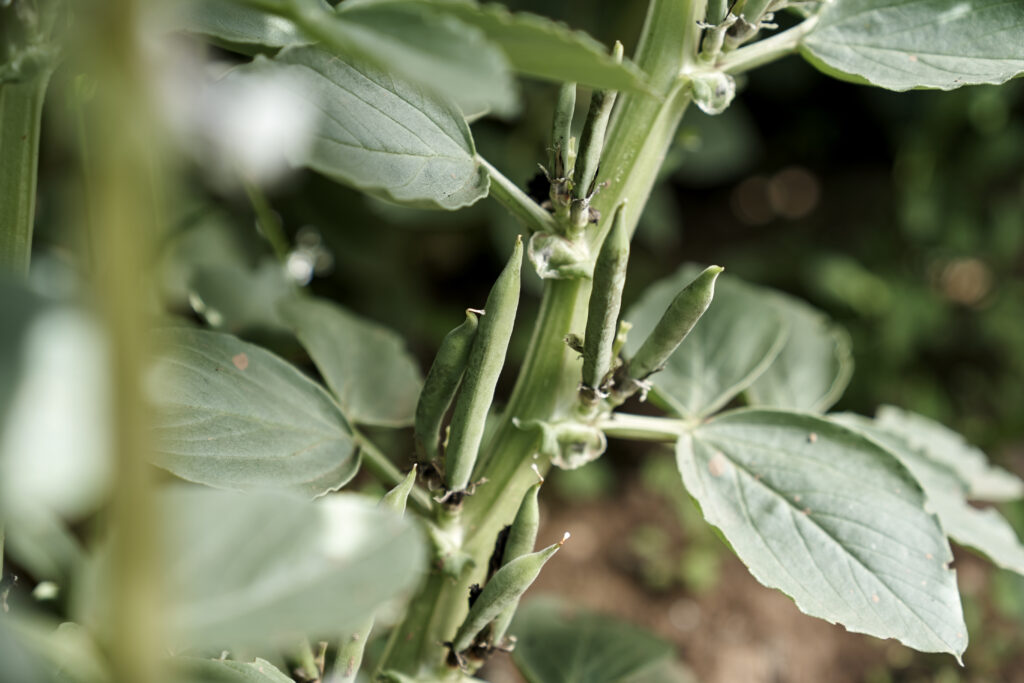 A photograph of our peas, which are now being harvested!
A photograph of our peas, which are now being harvested!
Planting & Growing
Our courgettes, marrows, spring onions and runner-bean plants are all growing steadily and they will be on track to begin their harvest in June. We are especially pleased with our broad bean crops which have reached about 15cm in height! We also plan to start harvesting them next month.
In May we started using our brand new robotic planter! This is a very exciting investment for us, as it uses GPS tracking to improve both planting density and accuracy, making planting easier and faster!
Banana bread is one of the best ways to use up those bananas which have started to look a little over-ripe. It is definitely one of our ultimate family favourites, and it is super easy to make!
Ingredients:
- 2 large eggs
- 3 large, ripe bananas
- 100g of dark chocolate chips
- 175g plain flour
- 2 tsp baking powder
- 1/2 tsp bicarbonate of soda
- 125g unsalted butter
- 150g sugar
Method:
- Mash the bananas with the back of a fork in a small bowl. This should be easy work if the bananas are very ripe!
- Use a wooden spoon to combine the flour, baking powder, bicarbonate of soda and salt in a bowl.
- Melt the butter in a small bowl – you can do this using either the cooker or the microwave!
- In another bowl, mix the melted butter with the sugar together.
- Once the butter and sugar have blended together, beat in the eggs one at a time.
- Add the mashed bananas to your sugar mixture and mix in well.
- Add the flower mixture to the batter a third at a time, make sure that it is all combined before adding any more.
- Add 85g of the chocolate chips to the batter and mix in well.
- Grease your loaf tin and then pour the mixture into it, before sprinting the remaining 15g of chocolate chips on top of the loaf.
- Place the loaf in the middle of the oven at 170 degrees celsius for between an hour and an hour and 15 minutes.
Tip: Let the loaf cool whilst it is still in the tin. That way is stops the bottom of the loaf from sticking to the inside of the tin!
This ratatouille is a great way of making sure you get all of your five-a-day in only one dish! Healthy, simple, and with only one pot it saves on the washing up too! What more could you ask for?
Ingredients:
- 3 small aubergines
- 3 medium courgettes
- 3 peppers (red and yellow)
- 2 red onions
- 6 large tomatoes
- 2 tins of chopped tomatoes
- 8 basil stalks(and leaves)
- thyme
- 4 cloves of garlic
- 2 tbsp balsamic vinegar
Method:
- Chop all of your vegetables into medium-sized chunks.
- Place a large dish on the heat and fry the vegetables, in a small amount of oil, until they are soft.
- Remove the vegetables from the dish and place them on the side.
- Add the onions, garlic, thyme and basil stalks to the pan, with some oil, on a medium to low heat. Place the lid on the pan and allow the onions to sweat until they are soft and start to caramelise.
- Add both the fresh and tinned chopped tomatoes to the onions, as well as the balsamic vinegar.
- Season with a pinch of salt and pepper to taste.
- Place the lid back on the dish and allow the mixture to simmer for 10 minutes, stirring occasionally.
- Add the rest of the vegetables to the dish, before replacing the lid, and put the dish in the oven at 150 degrees celsius for 40 minutes.
Why not make this dish your own by trying out different spices and flavourings?
Ratatouille is one of our favourites, because it is healthy, colourful and it goes with everything! Jacket potatoes, fish, meat or even pasta – the list is endless!
These easy breakfast buddies are a really good way to bring some excitement and creativity to breakfast time. We promise, they taste just as good as they look, and there are endless possibilities of characters that you could make!
Simply start with a normal piece of toast and then try out as many flavour combinations as you dare, in order to come up with your favourites. Here are a few of our suggestions to get you started…
- Peanut butter with bananas and blueberries.
- Chocolate spread with strawberries.
- Chocolate spread with bananas.
- Peanut butter with raspberries.
You can arrange the fruit in whichever way you fancy – to create flowers, animals or faces – there are endless possibilities! We like to use blueberries, bananas and strawberries but the more fruits you use, the more colour you can get into your toast pictures! You could even use different jams or other spreads for your backgrounds.
Send us some pictures of what you come up with!
These cupcakes are definitely one of our favourites. They make look simple but they are absolutely delicious. For the filling you can use homemade Lemond curd (recipe below), a shop bought one or none at all.
Ingredients:
- 3 eggs
- 6oz caster sugar
- 6oz butter
- 6oz self-raising flower
- 4 lemons
- milk
Method:
- Cream together the butter and the sugar in a mixing bowl.
- Beat in the eggs before sifting in the flour
- Add the zest of the lemons and a squeeze of lemon juice (not the juice of all our lemons) and mix.
- Finally add a splash of milk to the mixture before one last mix.
- Spoon the mixture into your cupcake cases. There should be enough batter to fill 12 cupcake cases nicely.
- Bake them at 180 degrees celsius for 12-15 minutes, until they are a golden brown colour.
If you prefer your cupcakes without filling or buttercream you can finish your cooking now, the cupcakes still taste delicious! However, we filled out cupcakes with lemon curd and topped them with buttercream
For the lemon curd filling:
- Add the juice of 3 lemons and their zest to a heatproof bowl, along with 100g of caster sugar and 50g of unsalted butter.
- Heat the mixture over a pan of boiling water and stir regularly until all the butter has melted.
- Whisk one egg and an extra egg yolk in a separate bowl.
- Add the whisked egg mixture to the heatproof bowl and whisk until all the mixture has combined.
- Let the mixture cook for 15 minutes or until it has thickened to a constituency which you are happy with.
- Let the lemon curd cool before filling the cupcakes.
Once your cupcakes have cooled use a knife to cut out a shallow core, before spooning your lemon curd into their centre.
If you don’t have time to make your own lemon curd then you can always buy some from the shops.
For the buttercream:
Whisk together 85g of softened butter and 175g of icing sugar before piping the mixture onto your cupcakes. You could always add some lemon juice for an extra fresh flavour.
Hash browns are one of our favourite parts of a big breakfast, but there is nothing better than making them yourself. They are really easy to make, very healthy and you only need 3 ingredients!
Ingredients:
- 3 medium sized potatoes
- 1 onion
- 1 egg
Method:
- Roughly grate the potatoes. You can swap out some of your potatoes for sweet potatoes if you fancy!
- Peel and grate your onion, adding it to the potato mix.
- Wash the grated potato and onion through before squeezing out all the moisture and drying them well.
- Beat an egg and add salt and pepper for seasoning (you could also add a few chilli flakes if you wanted).
- Add the egg to the potatoes and use your hands to mix in.
- Put the frying pan on a medium to high heat
- Use your hands to create flat balls of the potatoes mixture and place them into the frying pan. Make sure that they are not too thick.
- After 4-5 minutes flip the hash browns over to cook on the other side. You want them to be golden brown on each side (you could add a lid to the pan if you want them to cook a bit faster).
These hash browns are a delicious and you can eat them at any time of the day – as a snack, with breakfast, with a salad for lunch or as a side at dinner. We served them with some fresh avocado, cherry tomatoes and vegetarian sausages for brunch – what an easy way to get 3 of your 5-a-day.
These pancakes are super east to make and absolutely delicious! They are perfect for a filling breakfast and they are really healthy!
For this recipe you need to use 2 eggs for every banana that you use, it just depends on how many you want to make!
Ingredients:
- 2 bananas
- 4 eggs
- self-raising flour
Method:
- Peel the bananas and use a fork to mash them onto a chopping board.
- Whisk the eggs in a bowl, before adding in the mashed banana and whisking some more.
- Add a few heaped tablespoons of self-raining flour. The exact amount is up to you, but make sure the mixture is thick enough to stop it running too much in the pan.
- You could add in some berries and chocolate if you want to make your pancakes more interesting. Our favourite combination is blueberries and dark chocolate – make sure you chop up the fruit and chocolate into small pieces first.
- Heat some oil in a deep frying pan which has a lid.
- spoon the mixture into the pan in small circle shapes – we normally make three pancakes at a time but it depends on the size of your pan!
- Make sure you cover the pancakes with the lid when they are cooking – this means that they will cook all the way through before the bottom burns.
- When little bubbles form on the surface of the pancakes they are ready to be flipped.
- Cook for a few minutes on the other side before removing them from the pan.
The best thing about these pancakes is that you can serve them with all of your favourite toppings. Our favourite is yoghurt with fresh berries and a berry sauce, which we made from heating up some frozen berries and a little bit of water in a saucepan. What are your favourite toppings?
This dessert is absolutely delicious and it does not take much effort at all! You can try it out with different seasonal fresh fruits and even pair with homemade sauces or ice cream!
Ingredients:
- 4 egg whites
- 8 oz caster sugar
- 1 teaspoon of cornflour
- 500ml double cream
- 1 tbsp icing sugar
- 1/2 pineapple
- 3 kiwifruits
Method:
- Whisk the egg whites until they are stiff.
- Whisk the caster sugar into the egg whites, one teaspoon at a time, until all the sugar has been added.
- Whisk in the cornflour.
- Place some baking paper on your baking tray and spread the meringue mixture on top in a circle shape (roughly 23 cm diameter, but it can be bigger or smaller depending on what you want).
- Make sure your sides are slightly higher than the centre of the meringue.
- Place in the oven at 150 degrees celsius for an hour.
- Your meringue should be firm to touch and have a pale beige colour.
- Switch off the oven, but leave the meringue inside until it is completely cool.
- For the cream, whisk together the double cream and the icing sugar until it is stiff.
- Spread the cream over the meringue and add your chopped fresh fruit just before serving.
Ramadan is a very important date in the Islamic calendar, whereby muslims across the world fast between dawn and sunset. This means that they do not eat or drink from the time the sun rises in the morning, to when it sets in the evening. This lasts for an entire month, and this year Ramadan spans from the 23rd April to the 23rd May.
Dates play a very important role in the Ramadan festival. Three dates are supposed to be eaten at Iftar, which is the meal which breaks the fasting. This is because, in the Quran, the prophet Mohammed broke his fasting by eating three dates and some water.
 A farmer harvesting dates from a tree.
A farmer harvesting dates from a tree.
But why dates?
Dates are a very important fruit in the Middle East, an area which is home to a lot of muslims, and they have been grown there for over 7,000 years. Dates are known for their sweet flavour, but also their many uses. They can be used in sweet and savoury dishes, or eaten on their own as a snack.
Dates contain a lot of fibre, iron, potassium and magnesium which are good for the body. They are easily digested and they are also great source of energy, which makes them the perfect food to eat when finishing fasting.
Though dates are commonly associated with the muslim community, they are growing in popularity in communities across the world. Today the world’s leader of dates are Egypt, Iran and Algeria.
Our farms across the UK are constantly planting, growing and harvesting fruits and vegetables for you to eat! Here is an update on all the activities that have been happening over the past month with loads of photos to take a look at.
Harvesting
We harvested our first spring onion crops this week, and they are looking delicious! We have also been very pleased with our asparagus from this growing season, which we have been able to pick earlier than usual.
However, all the nice weather and hot temperatures has caused some flowering amongst the purple sprouting broccoli, which has decreased the amount of plants which we can send to the supermarkets. Purple sprouting broccoli grows best over the winter season, so we are now nearing the end of this years harvest!
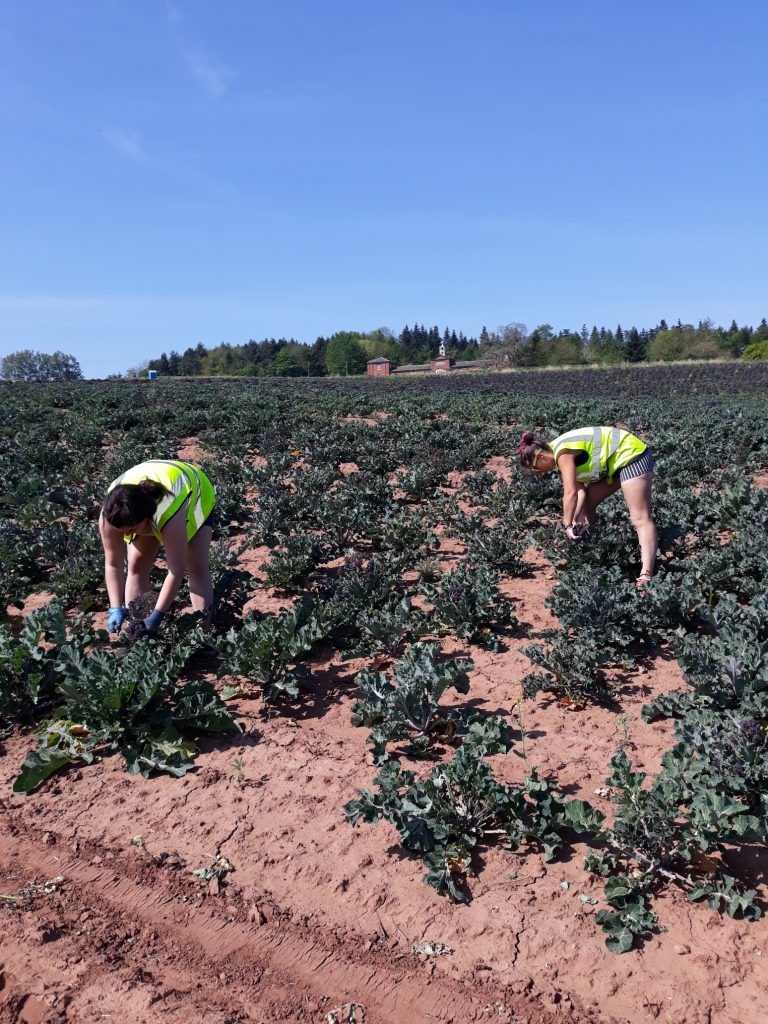 Harvesting the purple sprouting broccoli.
Harvesting the purple sprouting broccoli.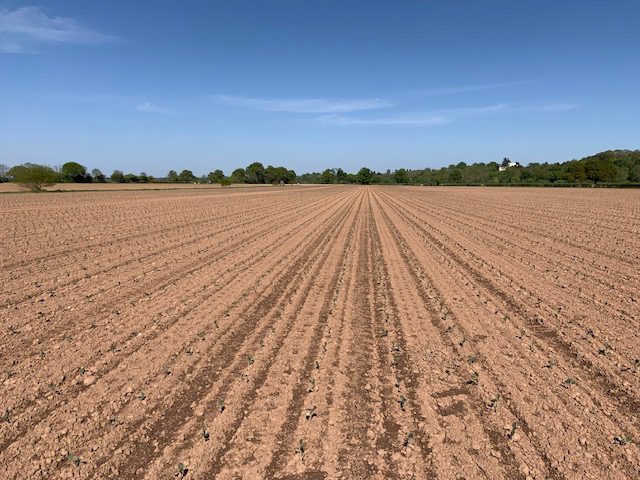 A view across one of the farming fields.
A view across one of the farming fields.
Planting & Growing
We often use protective fleeces to cover our younger plants, and protect them from birds and other predators during the growing process (take a look at the photos to see them in action!). Our tenderstem broccoli has been growing nicely and we will be able to remove their fleeces next week, at the beginning of may.
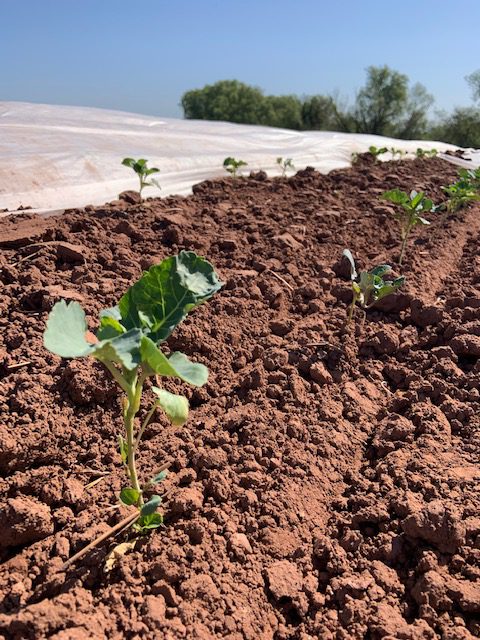 The fleeces are ready to come off the tendersteam broccoli!
The fleeces are ready to come off the tendersteam broccoli!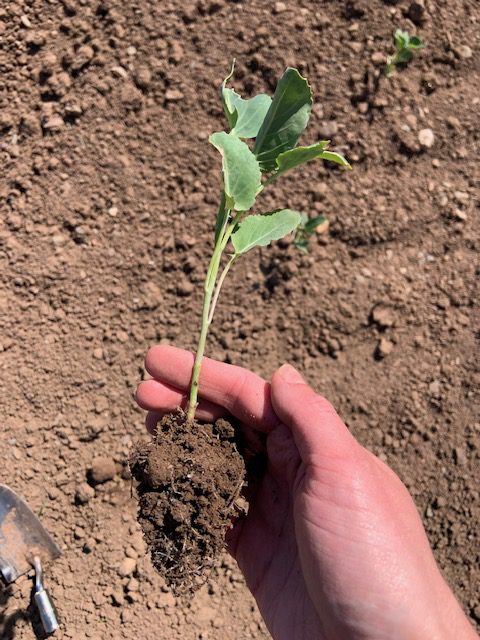 Look at how well our roots are growing!
Look at how well our roots are growing!
Many of our plants are grown from seeds in trays and are stored in large greenhouses. After the seeds sprout, and they grow much bigger, they are taken out of the trays and planted into the fields where they have more space to grow. This month we have planted out our Pak Choi, Choi Sum and Courgettes.
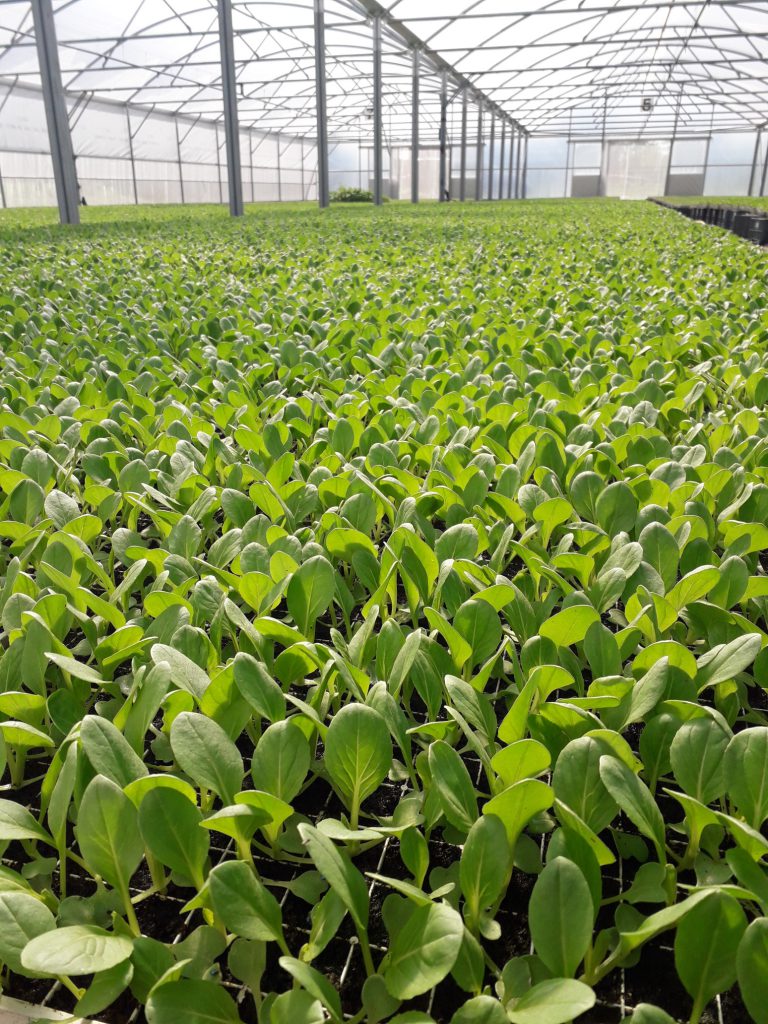 The Pak Choi ready to be planted out.
The Pak Choi ready to be planted out.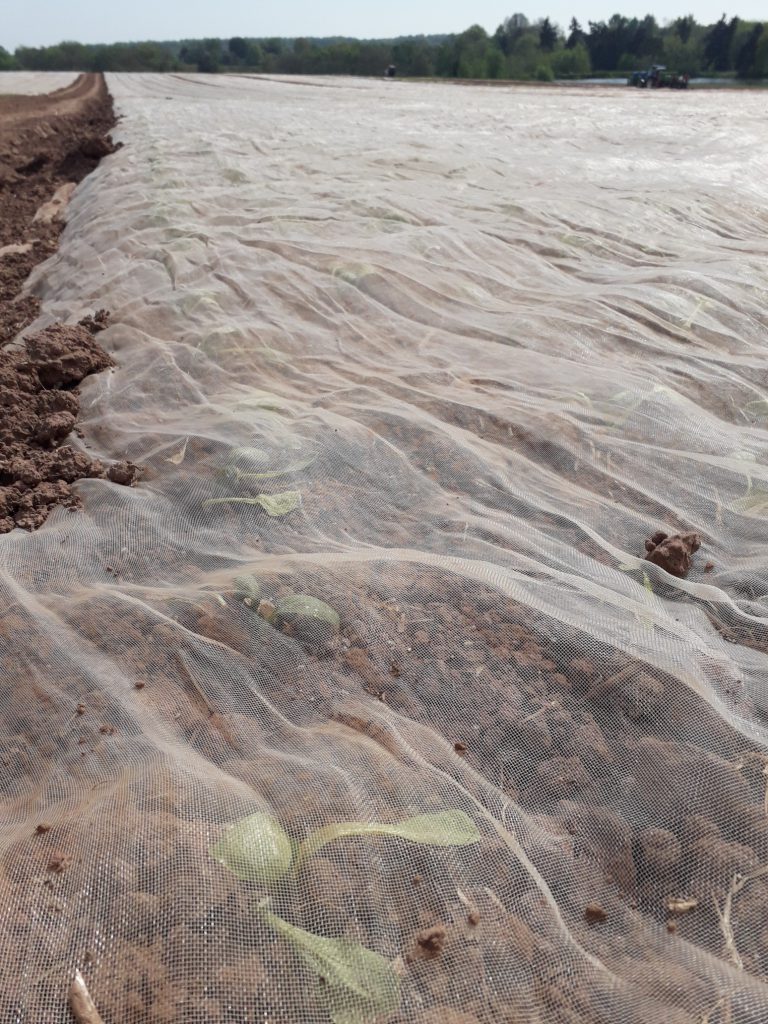 Pak Choi are protected by fleeces in the fields.
Pak Choi are protected by fleeces in the fields.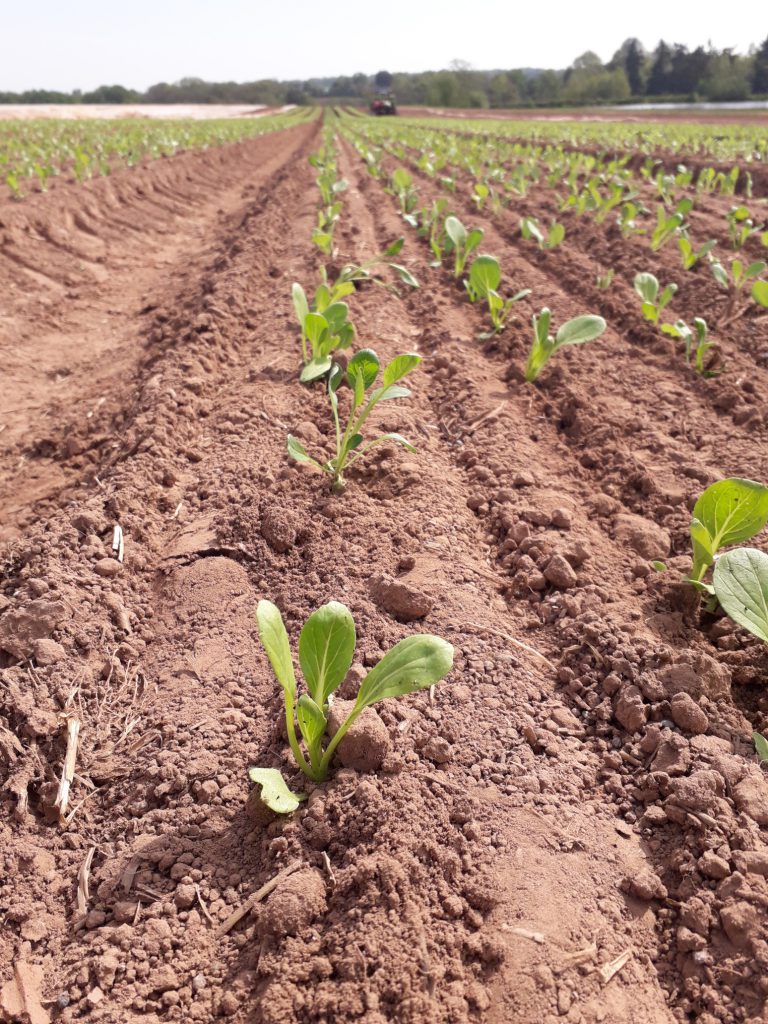 Pak Choi have been freshly planted out.
Pak Choi have been freshly planted out.
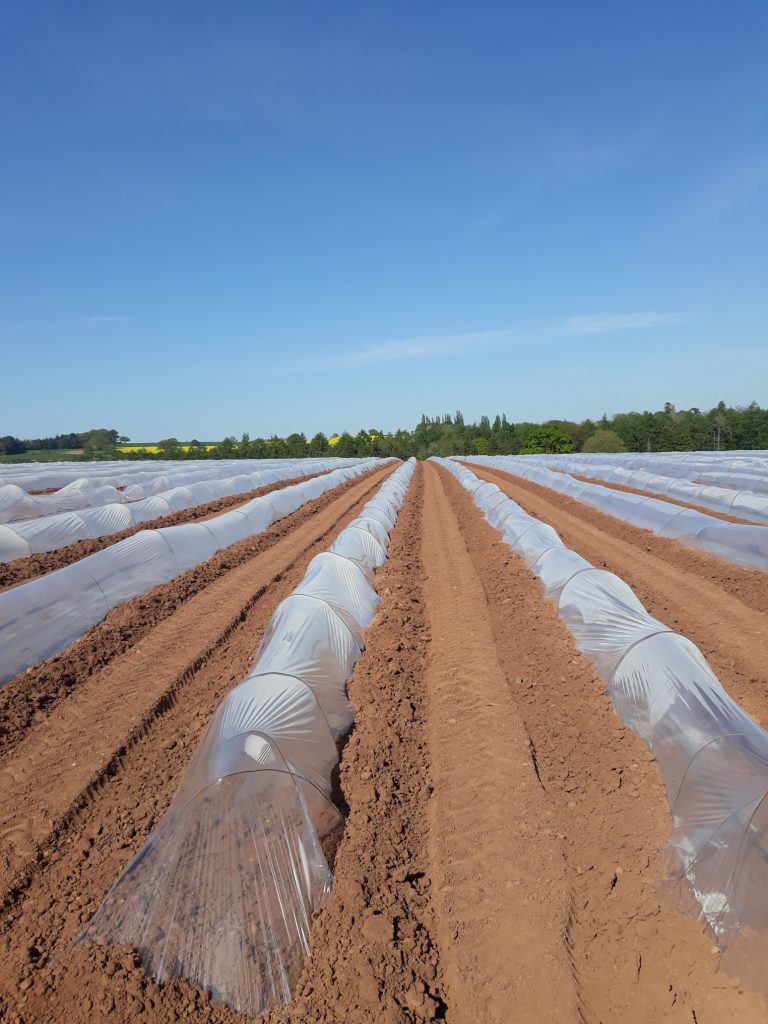 The beans have been planted.
The beans have been planted.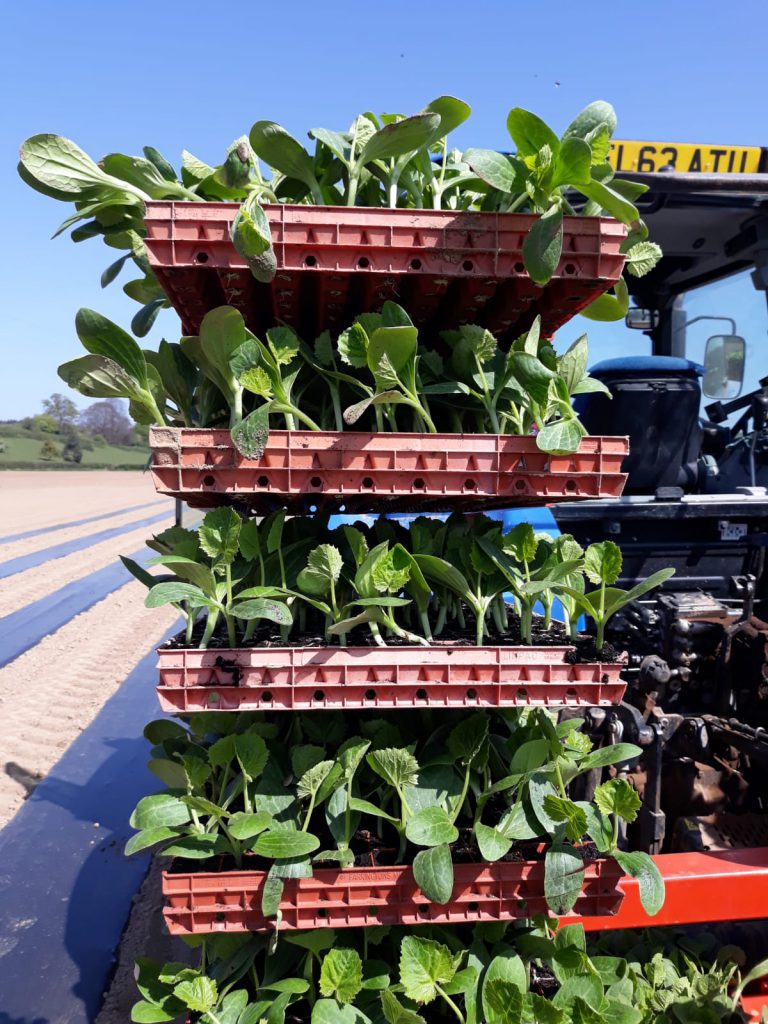 Courgettes are ready to be planted out.
Courgettes are ready to be planted out.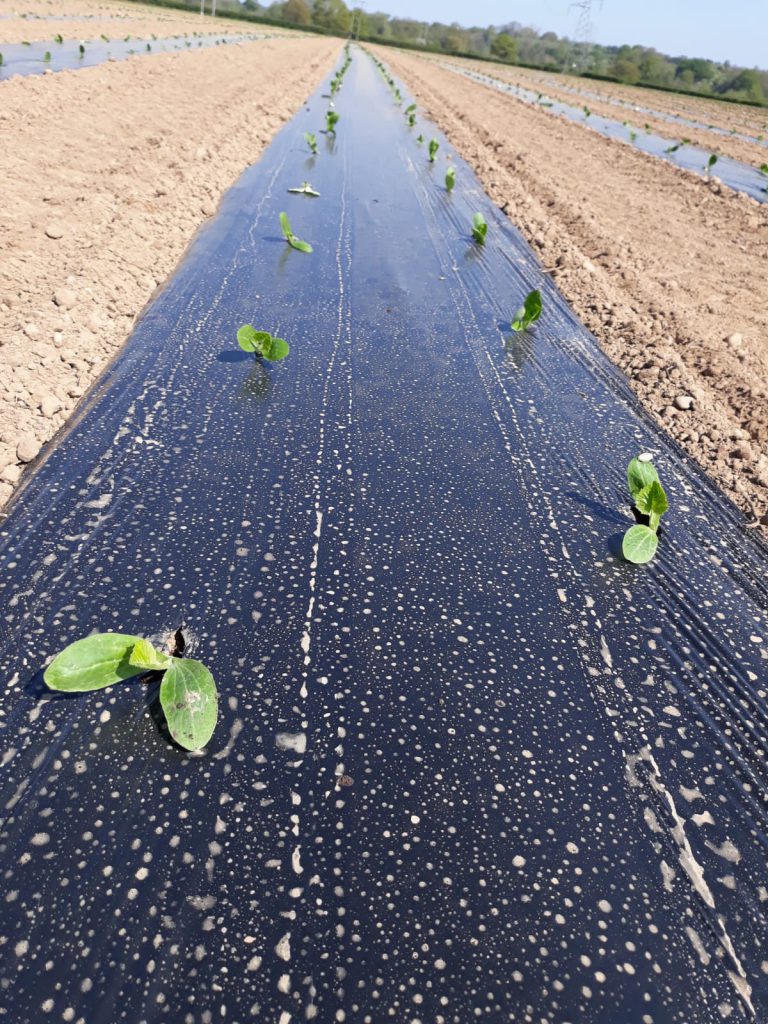 Courgettes which have been planted out.
Courgettes which have been planted out.
Finally, throughout April we have also planted our sugar snap peas and our beans. Make sure you look out for our next farming updates to see how they get on!
Fun Facts
- There are more than 8,000 varieties of apple worldwide. This is the largest number of any fruit to exist.
- Apples are grown on trees in fields called orchards.
- Some apple trees can live up to 100 years.
- Apple trees are between 1.8 – 4.6 metres tall. That is up to 2 and a half times taller than the average adult!
- Apples float in water as they are 25% air, without this you wouldn’t be able to do any apply bobbing at Halloween!
Where do we come from?
Apples are grown all over the world, at different times of the year. This means that we are able to supply you with apples all-year-round, but they come from different places depending on when you are eating them!
In the UK apple harvesting takes place from the end of August to early October. The biggest growing area in the UK is Kent, supported by the East of England. Apples also grow in Worcestershire, Herefordshire, Warwickshire, Suffolk and Hampshire. Other countries in Europe also grow apples at the same time of the year as the UK. The 3 biggest growers in Europe are Poland, Italy and France closely followed by Germany, Holland, Spain, Portugal and Greece.
From April to Mid-October we source apples from the Southern Hemisphere, in countries such as South Africa, Brazil, Chile, Argentina, Uruguay and New Zealand.
Test yourself! Can you locate all of these countries on the map?

Growing Conditions
Apples need specific conditions, in order for trees to flourish and produce ripe and juicy fruit. These conditions are individual to each type of fruit and vegetable, and they are very important for farmers.
- Full sunlight
- Well-drained, loamy soil
- Neutral soil – pH 6.0-7.0
- At least 60 cm of soil
In the UK, apple trees grow best when they are planted from late autumn to early springtime.
Our Journey
- Apple trees are grown in fields called orchards.
- When the apples are ready the are harvest by teams of trained pickers.
- The apples are then loaded into wooden crates and taken to a nearby packing facility.
- On arrival, the apples are washed to remove any unwanted dirt and all rotten apples are removed.
- The apples are stored in temperature-controlled rooms until they can be sorted.
- Each crate of apples is given a bar-code so that they can be tracked throughout the process.
- Apples are sorted by smart machines, to make sure only the best and tastiest apples make it to the shops.
- The apples are then packed and labelled.
- One last check is carried out by the packer, to make sure that all bad apples have been removed and thrown away.
- The packed apples are loaded into chilled transport vehicles and sent to the shops, where they are unloaded and put on the shelves for you to buy
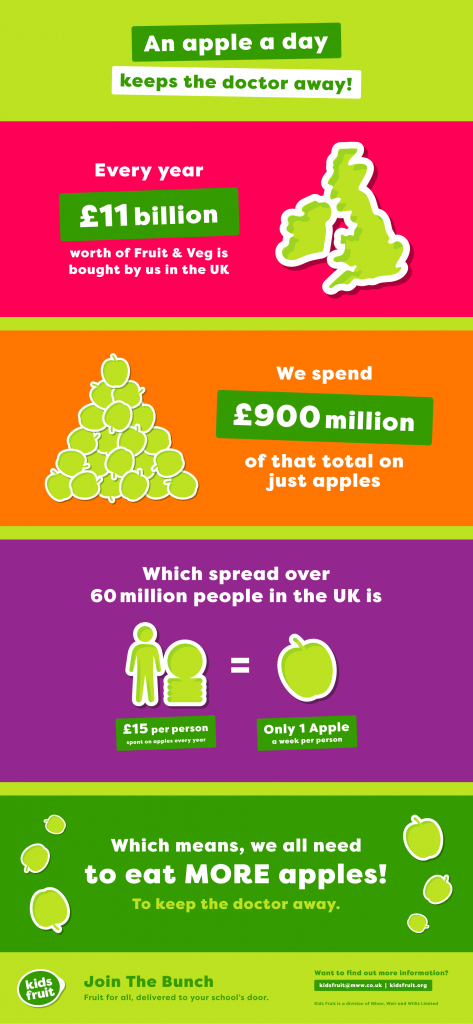
Are you eating enough apples?
We are good for you!
Apples help look after your body! They are high in both fibre and water which are very important for everyday bodily functions. They also contain lots of Vitamin C, Potassium and Vitamin K.
- Vitamin C is good for maintaining healthy skin, blood and bones.
- Vitamin K helps the body in its ability to heal wounds.
Well, you know what they say: an apple a day keeps the doctor away!
Did you know …
… Apples can help improve your memory, as they contain high levels of boron which stimulates electrical activity of the brain and increases mental alertness.
Quiz Question: How many famous apples can you name?
Apples appear all the time in different stories across history, in fairy tales and in everyday life. How many can you name? Here are a few to get you started …
Snow White’s poisoned apple.
Adam and Eve’s stolen apple.
Isaac Newton’s gravity apple.
New York City is often referred to as ‘the big apple’
Get Cooking: Homemade Apple Crumble
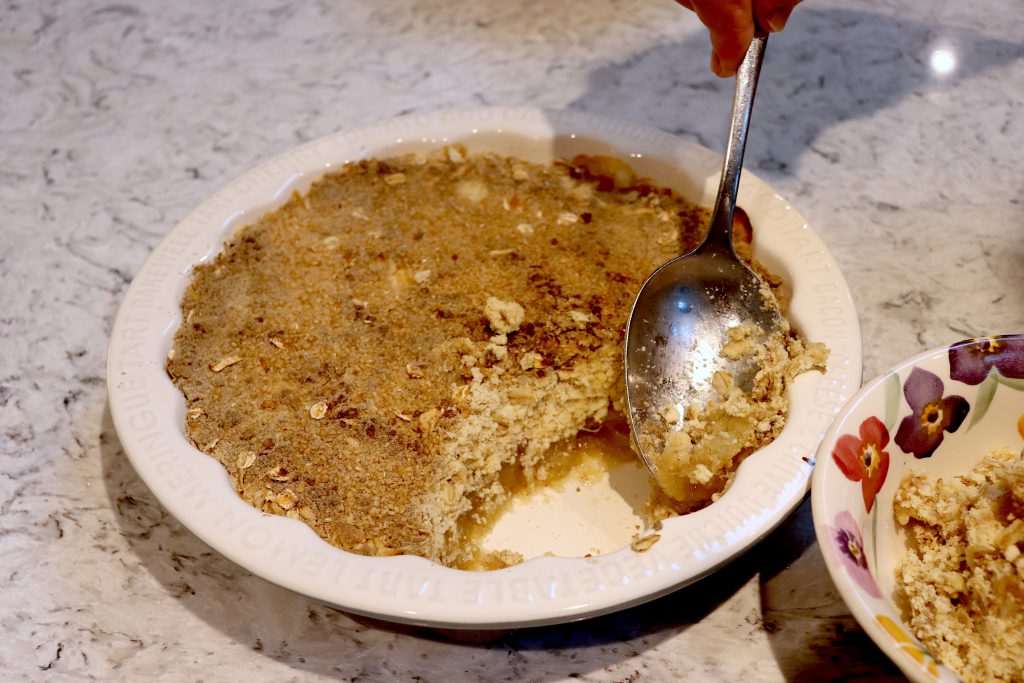
This dessert will definitely get everyone smiling! Click here for the recipe.
Fun Facts
- Bananas grow in large hanging bunches called hands.
- Bananas contain around 75% water.
- Humans share 50% of our DNA with bananas.
- Over 100 billion bananas are eaten every year in the world, making them the 4th most popular agricultural product.
- Unlike other fruits, bananas do not grow on trees. Instead, they grow on tall, soft-stemmed plants with palm-like leaves. They are classed as herbs because they do not have a strong woody stem. Rather, the trunk is formed by a mass of intertwined leaves.
- Bananas are picked from the plant when they are green. They then continue to ripen, after harvesting, to become yellow.
Where do we come from?
Bananas originally came from the Malaysian jungle region of South-East Asia, but now they are grown in tropical and sub-tropical regions all over the world!
We grow most of our bananas in Central and South America. These countries include Honduras, Costa Rica, Belize, Ecuador, Colombia and Brazil. However, we also grow some of our Bananas in Africa, in countries such as Ghana.
This means that the average banana travels 7,000 km from where it is grown before it reaches your kitchen in the UK!
Test Yourself! Can you locate all of these countries on the map?

We are good for you!
Bananas have many health benefits. Like all fruits and vegetables, they are low in sodium, calories and fat and they are also a good source of dietary fibre. But bananas are especially good for you because …
- They are a good source of vitamin C and B6
- They are a good source of potassium, which has been used to �lower blood pressure and in the treatment of �nervous disorders.
Our Journey
- Banana plants are grown from cuttings of more mature plants.
- Only 9 or 10 months after shoots are first formed, the bananas are ready for harvesting.
- Though the bananas are still very green, they are taken by overhead cable-way to a packing station.
- At the packing station, the bananas are cut into more manageable ‘hands’ of between 10 and 18 bananas.
- These ‘hands’ are cut into smaller clusters of between 3 and 7 bananas before they are washed in cool water tanks, to remove dust and cool them, in order to slow down the ripening process.
- After being washed, the bananas are checked for quality and then loaded into cardboard boxes for shipping.
- The bananas are shipped on boats, inside large temperature-controlled rooms. This is to try and slow down the ripening process during transportation.
- At the port, the bananas are transferred onto temperature-controlled lorries and taken to a ripening centre.
- After the ripening process is completed, the bananas are loaded back onto lorries and sent to supermarkets all over the country for you to buy!
Did you know …
… A monkey peels a banana upside down, compared to our way, by pinching the top and splitting the skin before peeling it down to reveal the fruit. This is easier and less damaging to the banana. Why don’t you give it a try?
Get Cooking: Frozen Banana and Peanut Butter Bites
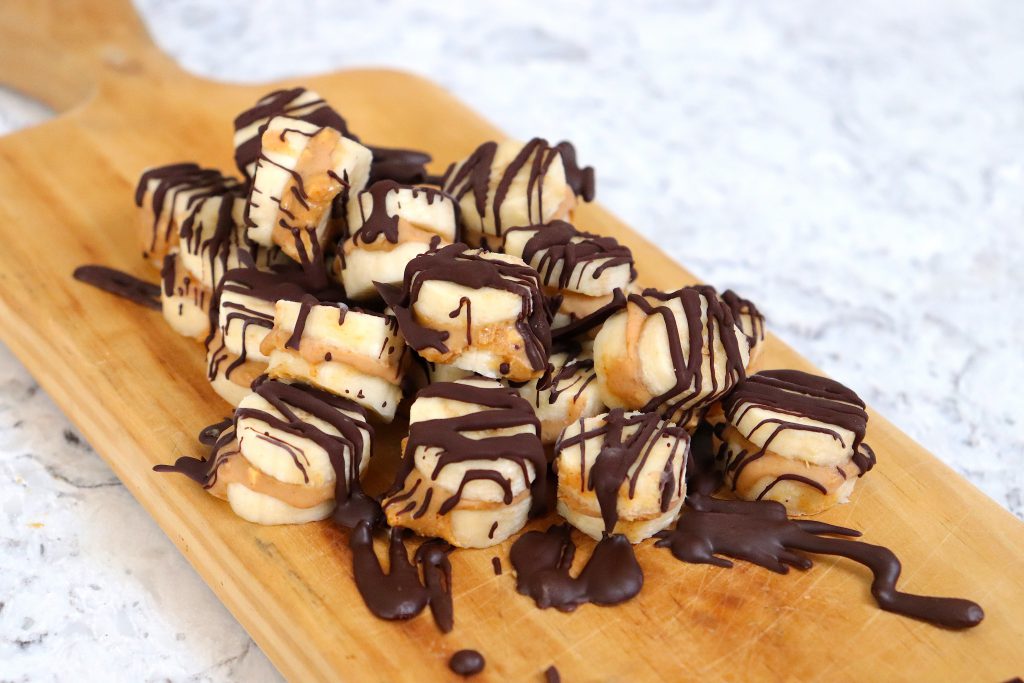
These are super quick and easy to make! They are really delicious and are perfect as a quick healthy snack, or an after-dinner treat. Click here for the recipe.
Fun Facts
- Carrots can be orange, red, yellow, white or purple in colour.
- Carrots are a type of root vegetable, this is because the edible part of the carrot is actually the root of the plant.
- Eating an excessive amount of carrots can turn a person’s skin yellowish-orange.
- After potatoes, carrots are the most popular vegetable in the world.
- The green tops of carrots are also edible, although not a lot of people know this.
- Carrots can be eaten raw (cut into sticks and eaten alone or with dips, sliced into rings or grated) or �cooked (boiled, baked, roasted or steamed and included in soups, stews and pies). They can also be used in sweet recipes, such as carrot cake and Christmas pudding, or juiced.
Where do we come from?
Carrots were first grown in the middle of Asia, 3,000 years ago, in a region which is now known as the country Afghanistan. However, today carrots are a very popular vegetable and they are grown all over the world.
Most of our carrots are produced in farms across the UK and Holland, but they are super easy to grow at home in your garden! Why don’t you give it a try?
Test Yourself! Can you locate all of these countries on a map?

We are good for you!
Like all fruits and vegetables, carrots are low in sodium, calories and fat and are a good source of dietary fibre. But carrots are especially good for you because …
- They are a good source of vitamin A which is good for both your skin and your immune system.
- They are a good source of the natural plant pigment beta carotene.
Grow your own at home!
Carrots are really easy to grow in your back garden at home, so why not give it a try? Carrots will not grow during the winter months, so you should try and plant seeds from February onwards, then the carrots with be ready for harvesting in June.
- Rake the soil where you want to plant your carrots. (Make sure the soil is deep enough because the carrots will grow downwards into the soil.)
- Make a small, shallow trench in the soil about 1cm deep.
- Thinly spread the seeds along the trench.
- If you want more than one row of carrots, make sure that the trench rows are about 15-30cm apart.
- Cover the seeds in a small amount of soil, until the ground is level.
- Don’t forget to water the seeds! Sometimes it can help to cover the plants in netting, to make sure the birds cannot eat them!
- The carrots should be ready to harvest and eat from June onwards.
Make sure you give it a try, we promise they will taste delicious! Don’t forget to email us pictures of your carrots, to add to our gallery.
Myth Busters …
Carrots don’t actually make you see in the dark! But they are a good supply of vitamin A, which helps improve your eyesight, as well as bones, teeth and skin.
Get Cooking! Homemade Carrot Cake
Fun Facts
- Another name for a dragon fruit is a ‘pitaya’
- A dragon fruit grows on a cactus, not a tree.
- The peel of a dragon fruit is normally pinkish-red or yellow, with wavy green leaves.
- The pulp (inside) of a dragon fruit can be red, pink or white and sprinkled with tiny, edible, black seeds.
- The dragon fruit flower blooms from evening to midnight, and so it is pollinated at night by moths and bats.
Where do we come from?
Dragon fruit was first grown in countries across Central and Northern South America. These included Mexico, Guatemala, Nicaragua, Costa Rica and El Salvador.
Today this fruit is becoming more and more popular. It is now grown all over the world in South-East Asia, America (especially Southern California and Florida), the Caribbean, Australia and across other tropical and sub-tropical regions.
Test Yourself! Can you locate all of these countries on a map?

I am good for you!
Like all fruits and vegetables dragon fruit is low in sodium, calories and fat and it is also a good source of dietary fibre. But dragon fruit is especially good for you because …
- Dragon fruit contains lots of vitamin C, which is good for your skin, blood vessels and your bones.
How to eat me!
It can be hard to figure out how to eat a new fruit or vegetable if you have never tried it before but don’t worry! It is very easy and the sweet, yummy taste means it is definitely worth it! Here are a few simple steps to follow, to make it simple:
- Select a ripe fruit with a bright and evenly coloured skin.
- Use a sharp knife to cut the fruit in half (get a parent to do this for you).
- Either use a spoon to eat the fruit from the inside of the skin or use a knife to peel the skin off, and slice it into smaller pieces.
Ideas for eating dragon fruit
Dragon fruit tastes a little bit like the combination of a kiwi fruit and a pear – we know, it sounds weird, but we promise it is delicious if you give it a try!
It is really yummy on its own, but it also goes great with many different dishes. Here are a few of our ideas to get you started, let us know what you think and try and come up with some ideas of your own!
- Chop it into small chunks, then add greek yoghurt and granola or nuts.
- Add it to a salad at lunchtime or as a side to a meal.
- Eat it with a little bit of ice-cream for a yummy dessert – vanilla is our favourite but it goes with all flavours!
Fun Facts
- Elderberries grow in swampy habitats and other areas with lots of water.
- Elderberry flowers are ivory white and very fragrant during blooms in spring and summer.
- The berries are purple or black in colour.
- Elderberry flowers are often used in jellies, jams, cakes and pies.
- You must only eat cooked elderberries – uncooked elderberries can kill you.
Where do we come from?
Elderberries grow across most of Europe and North America. They favour wet fertile soils, but they can also grow in dry and sunny locations. Whilst they can be used in cooking, they can often be considered weeds which grow along hedgerows across Britain and Nothern Europe.
Next time you go out for a walk, see if you can spot any! They are deep blue-black which grow on small trees along hedgerows. In spring they can be identified by their small white flowers.
Test yourself! Can you locate these regions on a map?

We are good for you!
Like all fruits and vegetables, elderberries are low in sodium, calories and fat and they are also a good source of dietary fibre. But elderberries are especially good for you because …
- They are a very rich source of vitamin C, which is good for your skin, blood vessels and bones.
- They have been found to reduce cold and flu symptoms and they are often used in liquids, capsules, lozenges and gummies which you can buy in the shops to do just this.
Quiz Question: How many different types of berry can you name?
The taste of elderberries is one of our favourites, but there are many other berries out there which we also enjoy! Some of these include Strawberries and Blueberries …
Can you think of any other berries which you enjoy eating?
Get Creative!
Draw, paint or build a picture of the beautiful elderberry flowers and then share it with us! We want you to be as creative and imaginative as possible. We cannot wait to see what you come up with!
Get Cooking! Elderberry Jam
Fun Facts
- Figs are considered as one of the oldest fruits.
- They have a sweet nutty taste and a soft chewy texture.
- Figs are not really fruits, they are flowers which are turned inside out! Inside the fruit are hundreds of tiny little flowers which are sweet and edible.
- This purple skin can be eaten, as well as the inside, but don’t forget to wash them first to make sure that they are clean.
- The skin of a fig can be purple, brown, green or yellow.
Where do we come from?
Figs were first grown in Eastern Turkey and across Northern India but they are mentioned throughout the history books as one of the oldest fruits. Both the Greeks and the Spartans are said to have eaten figs as one of their main sources of food.
Today, figs grow best in warm climates in many places across the world. Most of the figs that end up in supermarkets are grown in Italy, Turkey, Algeria, Greece, Portugal or Spain.
It has become very popular to try and grow figs in pots at home. If you have a greenhouse in the garden why don’t you give this a try? Make sure you let us know how you get on!
Test yourself! Can you locate all of these countries on the map?

I am good for you!
Like all fruits and vegetables, figs are low in sodium, calories and fat and it is also a good source of dietary fibre. But figs are especially good for you because …
- Figs are one of the best plant sources of calcium, which is good for your bones, muscles and blood functions.
Struggling to find fresh figs?
Sometimes fresh figs can be difficult to find in the supermarket, but dried figs are just as delicious, and they are normally in stores all year round! We recommend having them with ice cream or Greek yoghurt as a treat after dinner.
Did you know …
… Fig trees are a recurring theme in religion. Here are a few examples of where they are mentioned:
- Figs are the first fruit tree mentioned in the Bible, and some people believe it was the forbidden fruit in the Graden of Eden.
- Buddha received enlightenment under a fig tree.
- Islam considers figs to be holy.
- Hindus and Jains also consider a specific Asian species of fig to be sacred.
Get Cooking! Fig Jam
This is delicious, quick and simple to make. Click here for the recipe.
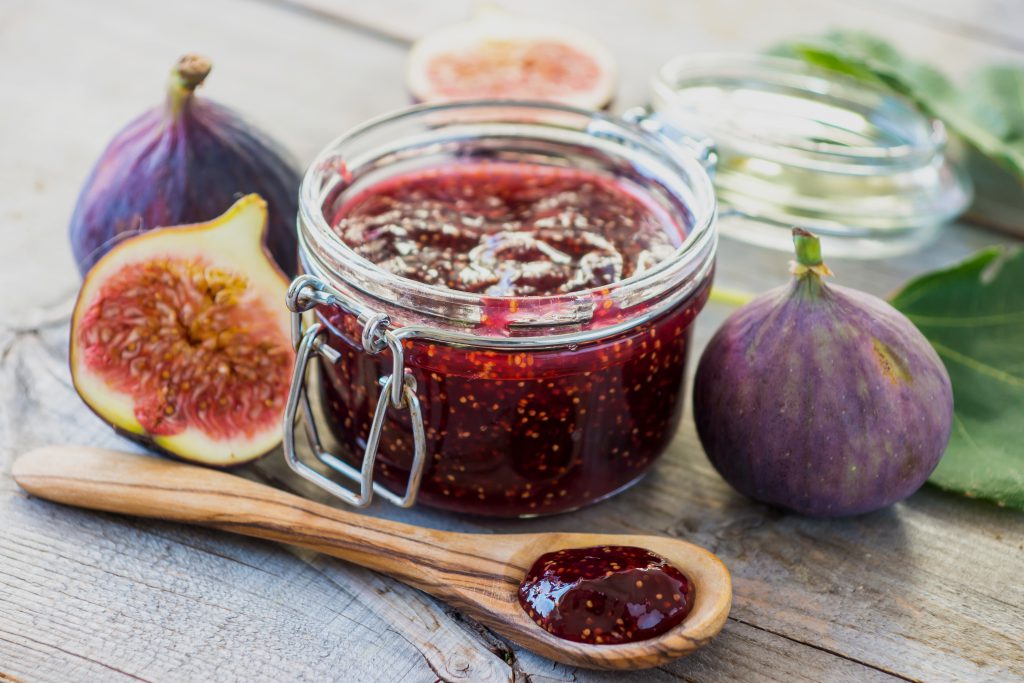
Fun Facts:
- There are more than 8,000 different types of grape.
- Dried grapes are called raisins.
- Grapes grow on vines in farms called vineyards.
- Grapes come in many colours, including red, green, purple, blue, black and pink.
- Grapes are actually a type of berry.
- Whole grapes are intended to be eaten straight away are called ‘table grapes’ but grapes can also be preserved into jam and jellies or crushed to make juice.
- Some grapes have seeds and some grapes don’t, but whilst the seedless ones may be easier to eat, the grapes without seeds are usually sweeter.
Where do we come from?
There are over 18 million acres of vineyards in the world. Most of the world’s grapes are grown in Italy, closely followed by American and France. However, there are many other countries which produce grapes as well, including Spain, China, Turkey, Argentina, Iran, Chile and South Africa.
Of all of these grapes, 27% are eaten fresh as table grapes, 2% are dried to produce raisins and 71% are used in making wine.
Test Yourself! Can you locate all of these countries on the map?

We are good for you!
Like all fruits and vegetables, grapes are low in sodium, calories and fat and they are also a good source of dietary fibre. But grapes are especially good for you because …
- They are a good source of vitamin K which is good for healing wounds.
Did you know …
…. Grapes were once considered the ‘fruit of the gods’. They are closely tied to Dionysus, who is the Greek god of wine, farming and fertility.
Get Creative!
Create a picture of a bunch of grapes and send us a photograph of your designs, be as creative and imaginative as you can!
Fun Facts
- Honeydew melons contain about 90% water, so eating melon it is a good way to stay hydrated and stop you from getting thirsty!
- A Honeydew melon usually has a smooth greenish-yellow peel and a pale green inside. However, sometimes the inside can be orange and this can be known as the ‘temptation melon’.
- Honeydew melons are sometimes called ‘winter melons’.
- Melons belong to the same family as squashes, pumpkins and cucumbers.
- The honeydew melon is the sweetest of all melons.
Where do we come from?
Honeydew melons were first grown in the Middle East, and because of their sweet and juicy flavour, they were once thought of as the sacred food of the Egyptians. Today, China and Turkey are the biggest growers of Honeydew melons around the world, closely followed by America.
Test yourself! Can you locate these countries on the map?

I am good for you!
Like all fruits and vegetables, honeydew melons are low in sodium, calories and fat and it is also a good source of dietary fibre. But honeydew melons are especially good for you because …
- They are a rich source of vitamin C which is good for your skin, blood and bones.
Get Creative!
Once you have eaten your delicious melon, save the seeds and dry them out. Then use them to create your how picture or design – send us a photo of what you come up with!
Recipe Challenge
We love eating honeydew melon with Parma ham- I know, fruit and meat sounds weird but why don’t you give it a try? Send us some photos of your favourite Honeydew melon recipes!
Fun Facts
- Iceberg lettuce is crunchy, juicy and mildly sweet in flavour.
- Iceberg lettuce is one of the only lettuce varieties that does not occur in red form, as well as green.
- It was originally given the title of ‘iceberg’ lettuce because large quantities of ice used to be used to prevent the spoiling of the lettuce in the trains, on their trips to the market.
- Iceberg lettuce tastes great raw and cooked – you could eat it in a stir fry or in a salad. We think both are just as delicious as each other!
Where do we come from?
Lettuce was first grown in ancient Egypt, where it spread to Greece and Rome before it was brought to Europe. Spain, America, Holland and Italy are the four countries which produce the most lettuce, closely followed by Mexico, China, Belgium and France.
Test yourself! Can you locate these countries on the map?

We are good for you!
Like all fruit and vegetables, iceberg lettuce is low in sodium, calories and fat and it is also a good source of dietary fibre. But, iceberg lettuce is especially good for you because …
- Lettuce contains lots of vitamin K which is good for helping the body to heal wounds.
- It has high amounts of vitamin A which is good for keeping healthy skin and boosting your immune system.
Grow your own at home!
Lettuce is really easy to grow in your garden at home, so why not give it a go? Lettuce grows best in cooler temperatures, so it is better to plant it in September so that it is ready for harvesting during the Autumn months. Lettuce contains a lot of water, therefore it does not store well, so it is best eaten fresh after you pick it.
- Rake the soil where you want to plant your lettuce.
- Make a shallow trench (thumb deep) in the soil.
- Sow your seeds in the trench, a finger space apart.
- Gently cover up the seeds with a thin layer of soil.
- Remember to keep the seeds watered and watch them grow!
Make sure you send us a photograph of your plants, we can wait to see how you get on. Or why don’t you send us some photographs of the meals you create with your lettuce. We love to hear all of your recipe ideas!
Experiment time!
Time to do some investigating! We want to know whether or not lettuce floats, just like an iceberg! Send us some photos of your discoveries, you could even try it out with other fruit and vegetables.
Recipe ideas
Lettuce can be eaten in loads of different ways, and we think that all of them are delicious. It goes great in salads and sandwiches but it can also be used in soups, like wraps, in a stirfry or in rice and noodle bowls. Why don’t you try to experiment with some different lettuce recipes and let us know how you get on!
Fun Facts
- Jackfruit is sometimes considered the king of fruits because it is also the largest tree fruit. They can grow up to 3 feet long and 18 inches wide, weighing up to 50 pounds.
- Jackfruit is the national fruit of Bangladesh.
- A fully ripe jackfruit is said to smell a bit like a pineapple and a banana.
- The skin of a jackfruit is made up of green spikes and is bumpy in texture.
- Jackfruit has so many uses – it can be eaten raw or cooked, and it is often used in jams, dried as chips or used to flavour ice cream.
- Jackfruit is often used as a plant-based meat alternative in vegetarian and vegan meals because when the fruit is unripe it soaks up flavour easily, and it has a stringy meat-like texture when it is cooked.
Where do we come from?
Jackfruit comes from south-west India. The trees typically grow in tropical and near-tropical conditions across the world. Today, the fruit is grown throughout the whole of India and across parts of south-east Asia including the Phillippines, Thailand, Malaysia and Indonesia. It can also be found in some parts of America, Australia, Hawaii, parts of Africa and it is very popular in Brazil.
Jackfruit is quickly increasing in popularity. Whilst it only used to be found in specialist food stores, it is now becoming more common in supermarkets. However, it is still unlikely that you will find it in your local small food and grocery shops.
Test yourself! Can you locate these countries on the map?

We are good for you!
Like all fruits and vegetables, jackfruit is low in sodium, calories and fat and it is also a good source of dietary fibre. But jackfruit is especially good for you because …
- It contains a lot of vitamin B6, which is good for boosting your energy levels.
- It is a good source of vitamin A, which is good for your skin and your immune system.
Struggling to find fresh jackfruit?
Jackfruit is very rarely sold fresh outside its countries of production, although it is getting more common in large supermarket stores. Instead, you could try using it tinned or as dried chips, which are usually more readily available in food shops.
Get Cooking! BBQ Pulled Jackfruit
This is such a great vegetarian and vegan alternative! Click here for the recipe.
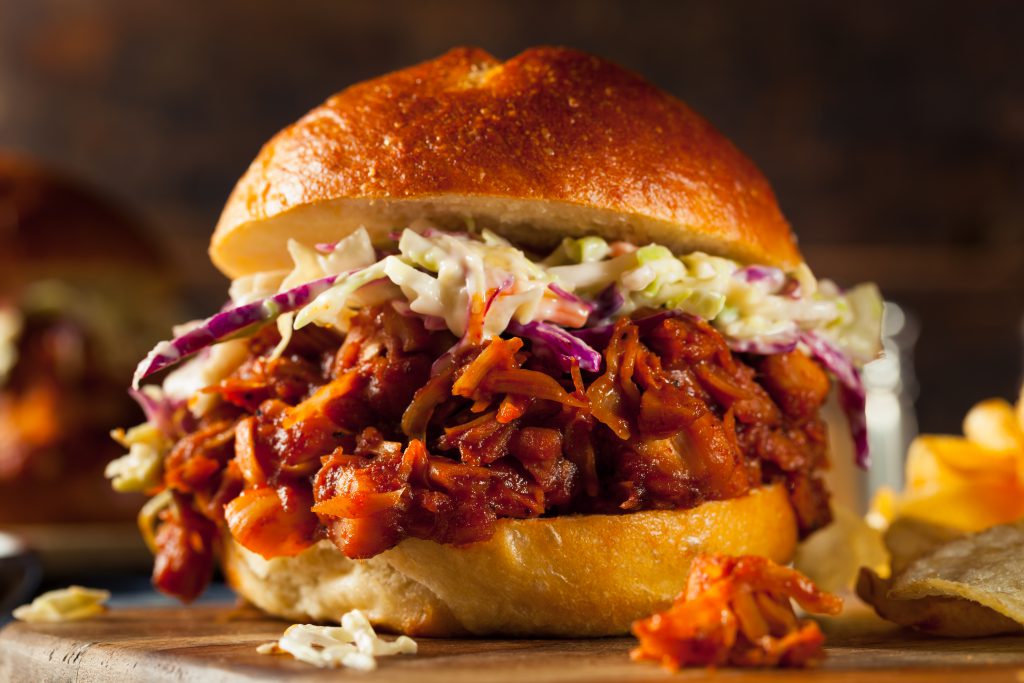
Fun Facts
- Kiwifruits are originally from China and they used to be called the ‘Chinese Gooseberry’ before they were renamed ‘Kiwi fruit’ in 1959 by the New Zealanders, due to its similar appearance to a kiwi bird.
- Kiwifruit has brown fuzzy skin and bright green flesh with circles of edible dark seeds in the middle.
- Kiwis are also eaten by many animals such as monkeys and deer.
- Kiwis are normally eaten raw in fruit salad or blended into juices.
- Eating 2 kiwi fruits an hour before bedtime will help you get a better night sleep.
Where do we come from?
As previously stated, the kiwifruit was first grown in China and it was only as recently as 1904 that the fruit was first grown in New Zealand, the country where the fruit gets its name.
Today, kiwifruits are grown not only in New Zealand but all across the world. It is also grown in Italy, France, Greece, Chile, China, Japan, South Korea and California, America. The growing season for kiwifruits is very long, lasting around 240 days.
Test yourself! Can you locate these countries on the map?

We are good for you!
Like all fruits and vegetables, kiwifruits are low in sodium, calories and fat and they are also a good source of dietary fibre. But kiwifruits are especially good for you because …
- They contain a lot of vitamin C, which is good for your skin, blood and bones.
Quiz Question
Kiwifruits were named because they look similar to the small, brown, furry kiwi bird in New Zealand. Can you think of any other fruits that look similar to different animals? Draw us a picture or send us a photo of the ideas that you come up with!
How to eat me
- Make sure you cut off the top and bottom and peel with a knife to get rid of the brown, furry skin.
- Kiwis are really yummy on their own, but they can also be good with different desserts. Why don’t you try it with ice cream or meringue?
Fun Facts
- Lemons have a sour taste to them! This is because they contain about 5-6% citric acid.
- Because of the citric acid in lemons, they can also be used in cleaning. If you dip lemon segments in salt or baking powder, they can be used to brighten up metal objects.
- Sprinkling lemon juice onto other fruits can stop them from turning brown!
- To power a flashlight bulb, you need 500 wired lemons to conduct electricity.
- The lemon shark is named because of its yellowish skin.
Where do we come from?
Lemons were first grown in the warmer countries in Asia, but today they have multiple uses including in different food, drinks and cleaning products.
India, Mexico, China, Argentina and Brazil are all leading growers of lemons. The plant is very sensitive to cold weather and therefore they grow best in sunny conditions with limited frost.
Test yourself! Can you locate these countries on the map?

We are good for you!
Lemons have many health benefits. Like all fruits and vegetables, they are low in sodium, calories and fat and they are also a good source of dietary fibre. But lemons are especially good for you because …
- They contain a lot of vitamin C which is good for your skin, blood and bones.
Did you know …
… Lemons have lots of vitamin C which means that they can be used to prevent a disease called scurvy. This was very common amongst sailors who were stuck on ships for months. Now, the British Navy requires ships to carry enough lemons so that every sailor can have 1 ounce of lemon juice each a day, to prevent just that.
Get Cooking! Lemon cupcakes
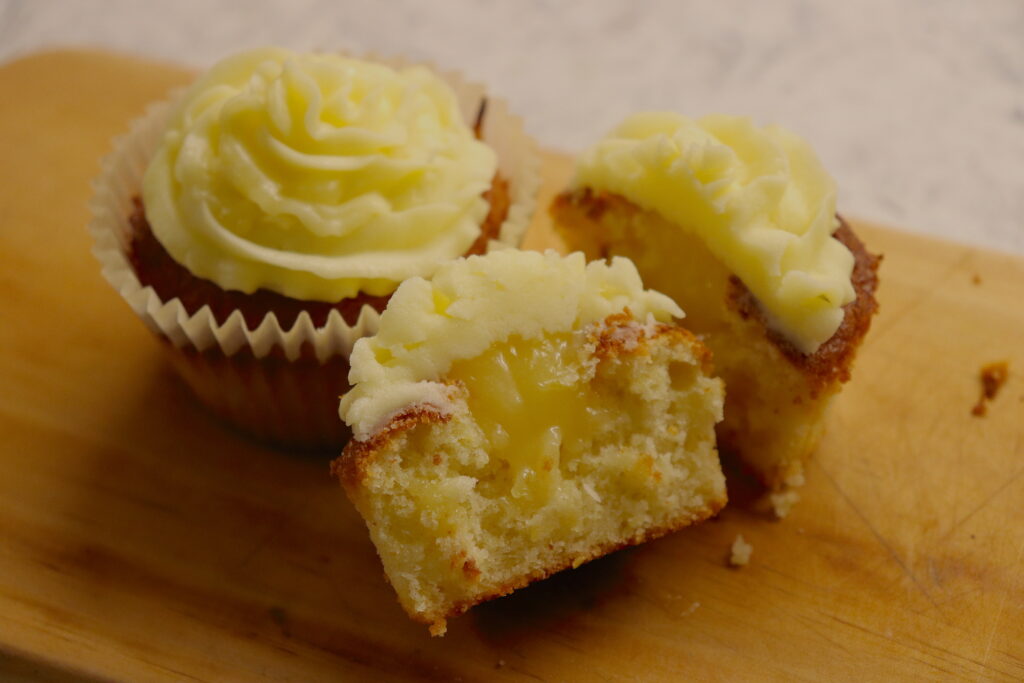
These cupcakes are absolutely delicious. The fresh lemon curd core is tangy and fresh and you can keep the leftovers in the fridge for another day. Click here to see our recipe.
Fun Facts
- In some parts of the world mangoes are called the ‘king of the fruits’.
- Mangoes can be many different sizes and colours, including yellow, orange, red and green.
- Giving someone a basket of mangoes is often considered a gesture of friendship.
- Unripe mango is often used in pickles or chutneys and sometimes it is eaten raw dipped in salt, black pepper, chilli, lime or soy sauce.
- Mangoes can be used in all types of cooking! It is often eaten fresh for breakfast or cooked in curries for dinner.
- Nearly half of the world’s mangoes are grown in India, but the country makes up less than 1% of the international mango trade. This is because most of the mangos grown here are also eaten in India.
Where do we come from?
The mango fruit was first found growing in India, Pakistan and Bangladesh. Since then, trade and travel have spread the mango fruit across the world and it has become one of the most popular fruits.
Today mango trees are grown in many tropical climates. These include India, China, Thailand, Mexico, Indonesia, Pakistan, Brazil and Egypt to name just a few.
Test yourself! Can you locate all of these countries on the map?

We are good for you!
Like all fruits and vegetables, mangos are low in sodium, calories and fat and are a good source of dietary fibre. However, mangoes are especially good for you because …
- They contain a lot of vitamin C, which is good for your skin, blood and bones.
Making mango hedgehogs!
Mangoes can be eaten and prepared many different ways but this is one of our favourites! But remember – knives are very sharp so you should get an adult to do this for you.
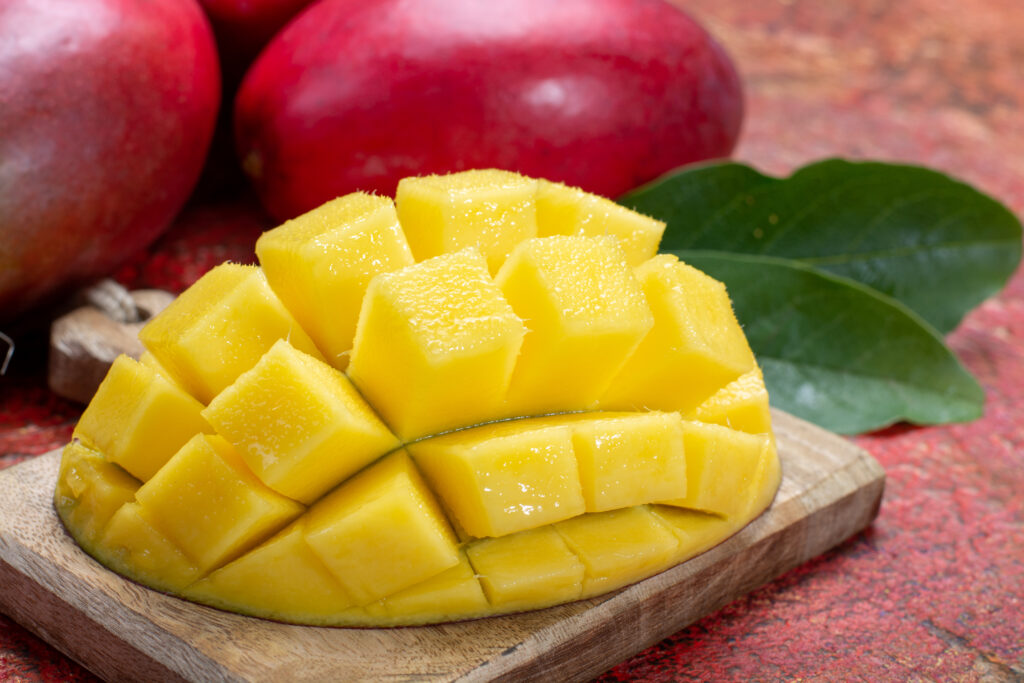
Firstly cut the mango into thick slices, either side of the stone. Then use your knife to score vertical lines into the yellow flesh – make sure that you don’t cut the skin! Then repeat this step for horizontal lines. Finally, use your fingers to push up in the middle of the mango skin. The result should look like this photo – just like a hedgehog!
Get Creative!
Can you think of any other fruits or vegetables that you can turn into animals? Let us know!
Fun Facts
- Nectarines get their name from ‘nectar’, which was the sweet fruit that the gods ate.
- Nectarines and roses are from the same family.
- They grow on trees which are normally between 5 and 7 metres tall.
- Different types of nectarines have different colour flesh. They are normally yellow, reddish or white in colour.
- Nectarines are a stone fruit as they have a large seed in the centre.
Where do we come from?
Nectarines were first grown in China but now they are grown all around the world. Whilst China still grows the most nectarines, other countries such as Spain, Italy, Greece, America and Turkey also are also large producers. Iran, Chile, Argentina and Turkey also grow nectarines as part of the global trade.
Test yourself! Can you locate all of these countries on the map?

We are good for you!
Like all other fruits and vegetables nectarines are low in sodium, calories and fats and they are also a good source of dietary fibre. However, nectarines are especially good for you because …
- They contain lots of vitamin C which is good for you skin, bones and blood.
- They contain lots of vitamin A which is good for your skin and your immune system.
Did you know …
… people often get confused between nectarines and peaches but here is the difference – whilst they both have a similar shape, size, colour and seed they have very different smells, textures and flavours. The most obvious way to remember is that nectarines have a smooth skin, whereas peaches have a fuzzy feel to them.
Get Cooking! Nectarine and yoghurt dessert
Fun Facts:
- There are over 600 different types of oranges grown across the world.
- About 85% of all oranges are used to produce juice.
- There are normally only 10 segments inside an orange.
- Orange blossom flowers are white and have a strong smell. They are commonly used as decorations on wedding cakes, in bouquets and head wreaths.
- Orange jam is also known as marmalade.
Where do we come from?
Oranges were first grown in China but now they are grown in both tropical and sub-tropical climates across the world. Most of the world’s orange production happens in the Northern Hemisphere in countries such as China and America but they are also grown in countries such as Brazil, Mexico, India, Spain and Egypt.
Test yourself! Can you locate all of these countries on the map?

We are good for you!
Like all fruits and vegetables, oranges are low in sodium, calories and fats and they are a good source of dietary fibre. However, oranges are especially good for you because …
- Oranges contain a lot of vitamin C which is good for you skin, blood and bones..
Did you know …
… orange peel can be used as a slug repellent. It is used by many farmers on their vegetables – why don’t you give it a try with your plants?
Get Cooking: Fresh orange juice
Fun Facts
- Peppers are technically a fruit and they belong to the same family as potatoes and tomatoes.
- Everyday peppers which are used in salads are called bell peppers.
- Peppers come in a rainbow of colours including red, yellow, green, orange, brown and purple.
- Bell peppers were named by Christopher Columbus when he was searching for black pepper.
- Peppers can be hot, like chilli and cayenne peppers, or mild, like bell and sweet peppers.
- Although you might think that larger chilli peppers have more spice to them, the smaller and thinner the pepper is the spicier the chilli will be.
Where do we come from?
Different types of peppers are grown all across the world. Most bell peppers are grown in China, closely followed by Mexico, Turkey, Indonesia and America. Whereas black pepper is mainly produced in India, Vietnam and Indonesia.
Test yourself! Can you locate all of these countries on the map?

We are good for you!
Like all fruits and vegetables bell peppers are low in sodium, calories and fats and they contain lots of dietary fibre. However, bell peppers are especially good for you because …
- They contain lots of vitamin A which is good for your skin and your immune system.
- They contain lots of vitamin C which is good for your skin, blood and bones.
Get Cooking: Pepper stir-fry
Fun Facts
- A quince tastes like a blend between an apple and a pear.
- The flowers on a quince tree are produced in spring, after their leaves have grown. They are pink or white and have 5 petals.
- Quinces are not eaten fresh, but they are particularly popular for use in jams and jellies.
- Alternatively, quinces are an ideal fruit for poaching, stewing or baking in desserts.
- In the Middle Ages quinces were considered valuable, and often served at important banquets for monarchs and aristocrats.
Where do we come from?
Quinces were first grown in Southern Asia, and whilst they remain a relatively uncommon fruit, they are now grown on all continents in warm and temperate climates. The top three leading growers of quinces are in Asia, namely Turkey, China and Uzbekistan. However, other countries such as Morocco, Iran, Argentina, Azerbaijan, Spain, Serbia and Algeria also grow quinces in large volumes.
Test yourself! Can you locate all of these countries on the map?

I am good for you!
Like all fruits and vegetables, quinces are low in sodium, calories and fats and they are a good source of dietary fibre. But quinces are especially good for you because …
- They contain a lot of vitamin C which is good for your skin, blood and bones.
Challenge …
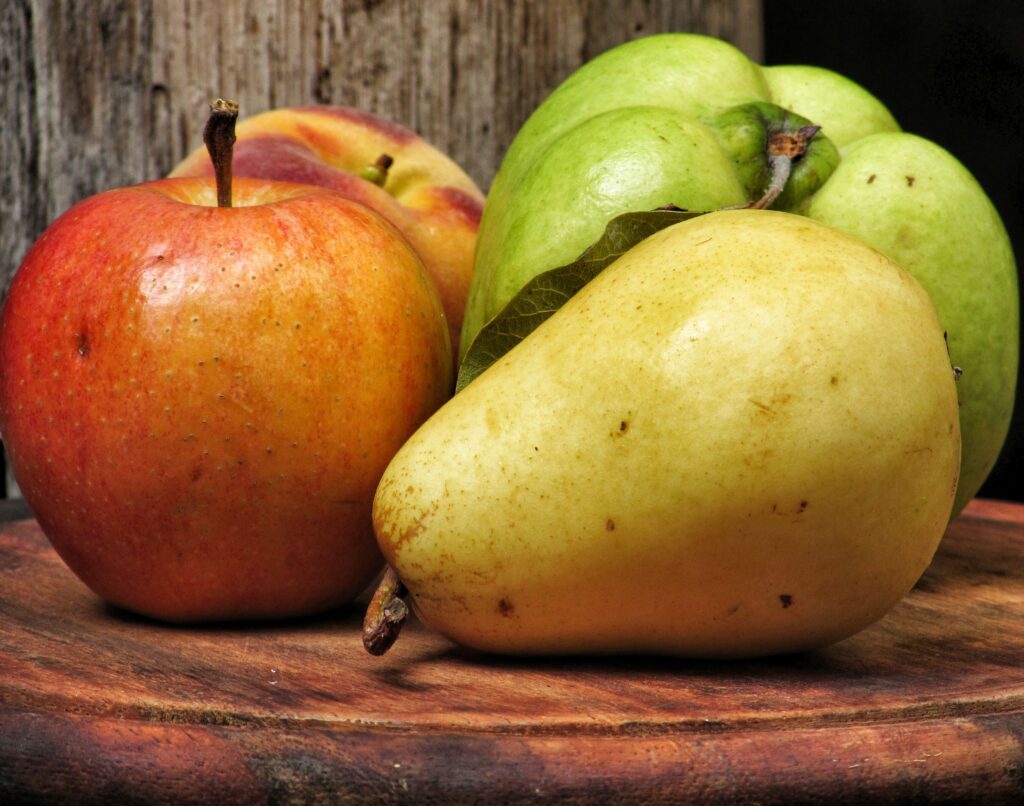
… Quinces, apples and pears have many similarities and differences – can you spot them all?
Get Creative!
If you cut fruits in half you can use them as a stamp for printing – why don’t you give it ago? Using quinces, apples and pears create a print using different coloured paints and sections of fruit.
Fun Facts
- Raspberries can be red, purple, gold or black in colour. The gold raspberries are the sweetest and the yellow ones are the most fragile.
- Raspberries were once a symbol of kindness.
- Raspberries do not ripen any further after they are picked.
- Scotland is famous for its raspberries.
- There are over 200 varieties of raspberry.
Where do we come from?
Raspberries were first grown in Europe but now they are popular across the world. Today Russia is the worlds leading grower of raspberries, closely followed by Poland, America, Serbia and Mexico.
Test yourself! Can you locate all of these countries on the map?

We are good for you!
Like all fruits and vegetables, raspberries are low in sodium, calories and fate and they are also high in dietary fibre. However, raspberries are especially good for you because …
- They contain lots of vitamin C which is good for your skin, bones and blood.
Fruit Myths
- According to legend raspberries use to be white. A nymph called Ida pricked her finger whilst collecting them for infant Jupiter and then berries have been blood red ever since.
- A German myth claims that raspberries are magic. In order to tame a wild horse, it is believed you would have to tie a wild raspberry twig around its body.
Get Cooking! Raspberry Smoothie